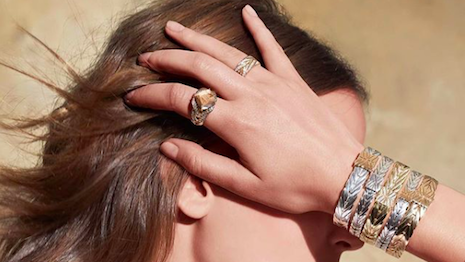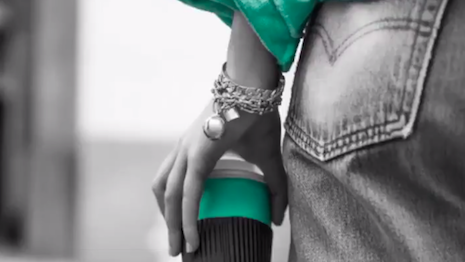 John Hardy is one of the brands that has appealed to the self-purchasing woman. Image credit: John Hardy
John Hardy is one of the brands that has appealed to the self-purchasing woman. Image credit: John Hardy
Contrary to traditional marketing that positions jewelry as a gifting item, millennial women are more apt to buy pieces for themselves than to receive them from others.
A new report from MVI Research found that more than half of millennial age women indicate themselves as the primary buyer of jewelry in their households. Luxury marketers have begun to evolve their messaging surrounding jewelry, but as millennials become a bigger consumer base for high-end goods, it will become even more important to appeal to women themselves.
"The [jewelry] industry needs to change dramatically because even today, just about every jewelry product that winds up being worn by women is either made by men or the organizations are run by men," said Marty Hurwitz, CEO of MVI Marketing, Austin, TX. "So the industry needs to embrace this opportunity, it needs to bring more women into the pipeline—the product development pipeline, the management pipeline—and it needs to understand that this consumer really needs a female voice and a female aesthetic talking to her."
MVI Marketing’s "Self Purchasing Females: Luxury Growth Demographic of Opportunity" report is based on a survey of 1,000 women between the ages of 25 and 40 with household incomes of at least $75,000.
Gifting vs. getting
MVI’s study found that only 18 percent of respondents named their spouses or romantic partners as the primary buyer for jewelry. Seventeen percent say they shop with their partner, while 13 percent say they primarily buy jewelry as a gift for their significant other.
While women tend to self-purchase jewelry at a high rate, they are even morel likely to buy their own shoes, with 69 percent saying they are the most common shoe shopper in their home. The respondents’ importance to the footwear market also extends to gifting, with 19 percent of women saying they mainly buy for their partner.
MVI also looked at hotels, and found that women were almost evenly split between purchasing for themselves and collaborating with their significant other to book a room. About three in five women say they never travel alone, but 65 percent of millennials take at least one trip with their girlfriends per year.
Women are apt to take girls' trips. Image credit: Mandarin Oriental
Self-purchasing is primarily driven by women wanting to control what they get. About a third of those surveyed said that they buy for themselves because they desire something specific.
While these purchases may not be a present in the traditional sense, about one in five women say they choose to self-gift to mark an occasion, such as a divorce or a birthday.
When deciding what to buy, 90 percent of women say they conduct research.
Certain brands have captured the attention of millennials.
In jewelry, Tiffany is the top brand that millennial women say they already own or would plan to buy in the future, followed by Pandora and Swarovski. Those surveyed show a preference for diamond jewelry designs and white gold.
Tiffany has the attention of millennial women. Image credit: Tiffany
Consumers show a preference for Coach and Kate Spade footwear. However, consumers are also apt to say that they have no plans to buy from a number of popular luxury labels such as Gucci and Jimmy Choo in the future, with 27 percent choosing none of the brands MVI mentioned in the survey.
Millennial women are also undecided on hotel chains. After Hilton and Marriott, the respondents said they had no preference.
These consumers are at an age where their brand choices are not set in stone, leaving room for brands to begin potentially long-lasting relationships with them.
Despite the focus on millennials and social media, only 14 percent of respondents say they discuss brands frequently on social media. When they do talk about brands, 62 percent say they are most apt to post on Facebook.
The brands succeeding with young women are the ones using content effectively.
"This younger consumer in general is very suspicious of anything that smacks of discounts, deals, anything that has to do with shopping like their parents did," Mr. Hurwitz said. "Anything that looks slick is slick, and is not to be trusted.
"Whereas anything that is organic and creative and not particularly Madison Avenue slick, that is interesting, engaging content that people will follow, glom onto or share," he said.
Mr. Hurwitz also suggests that brands include women in their marketing and product development teams.
Self-purchasing promotions
Jeweler John Hardy positioned its pieces as an empowerment tool through a campaign that spoke to feminine strength.
The brand’s new “Made for Legends” platform centers on the idea that jewelry is more than just adornment, as it can also be a means of expression. Appealing directly to women, the effort intends to turn these female fans into purchasers themselves, subverting the traditional notion of jewelry as a gifting item (see story).
Taj Hotels Resorts and Palaces is encouraging guests to make exciting memories with family and friends at its properties through playful narratives.
A new video campaign shows scenes from family vacations and girls’ trips, urging travelers to get away for some #WeTime — a play on the popular phrase “me time.” Instead of emphasizing its hotels’ services or amenities, the campaign focuses on experiences as a whole.
One of Taj's #WeTime videos features a trip among girlfriends celebrating one of their divorces (see story).
"If we can capture the attention [of millennial women] now and even get them to test some brands and products in jewelry, shoes, travel, etc., they will probably be with us as brand loyalists, brand advocates for 30-plus years," Mr. Hurwitz said.
"As a 25 year old turns into a 35 year old or a 40 year old, generally they’re making more money and they retain a lot of those brand loyalties," he said. "So it’s a big growth opportunity for luxury brands, retailers, manufacturers that are willing to invest a little marketing spend now with this younger consumer to bring them along, to capture their attention now."

